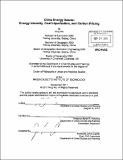| dc.contributor.advisor | Karen R. Polenske. | en_US |
| dc.contributor.author | Wu, Ning, Ph. D. Massachusetts Institute of Technology | en_US |
| dc.contributor.other | Massachusetts Institute of Technology. Dept. of Urban Studies and Planning. | en_US |
| dc.coverage.spatial | a-cc--- | en_US |
| dc.date.accessioned | 2012-01-30T16:57:23Z | |
| dc.date.available | 2012-01-30T16:57:23Z | |
| dc.date.copyright | 2011 | en_US |
| dc.date.issued | 2011 | en_US |
| dc.identifier.uri | http://hdl.handle.net/1721.1/68884 | |
| dc.description | Thesis (Ph. D.)--Massachusetts Institute of Technology, Dept. of Urban Studies and Planning, 2011. | en_US |
| dc.description | Cataloged from PDF version of thesis. | en_US |
| dc.description | Includes bibliographical references. | en_US |
| dc.description.abstract | In my dissertation I explore three independent, but related, topics on China's energy issues. First, I examine the drivers for provincial energy-intensity trends in China, and finds that technology innovation is the key driver. Then, to understand how technology innovation takes place, I examine coal-to-liquids technology and argue that companies' business diversification strategies are the key driver for the coal-to-liquids development in China. Third, I study the carbon pricing carbon capture and storage, which supplements the other two from the perspective of finance: the impact of carbon price on investments on carbon capture and storage for power plants. (1) Provincial energy-intensity (EI) change in China: a case study of three provinces El trends of individual provinces vary, although the whole country shows declining energy intensity. The energy-intensity trends in the following three provinces seem especially interesting: Inner Mongolia, Liaoning, and Ningxia, because they represent three typical El trends in China, increasing, nearly constant, and decreasing. Then why and what is the driver for this difference in energy-intensity trends? I argue that technology innovation plays a key role. I also explore the economic structures and development of renewable energy in three provinces to shed light on how these might affect energy-intensity change in these regions. (2) Coal to liquids: why and how it makes the case in China Different from Europe and the United States, China is actively developing coal-to-liquids technologies and projects. In contrast to the conventional wisdom that in China the central govemment mandates and guides coal liquefaction to ensure energy security, I argue that the diversification strategy of state-owned coal companies is another key driver for coal-liquefaction development in China, in addition to the state interest and policy that initiated this move. Given current extensive conversation and debate on Chinese technology innovation capability, my research sheds light on the innovation system in China and provides implications for technology policy and investments. (3) The impact of future carbon prices on CCS investment for power plants in China I answer two related questions about the development of carbon capture and storage (CCS) and power generation technologies in China: (1) what is the breakeven carbon-dioxide price to justify CCS installation investment for Integrated Gasification Combined Cycle (IGCC) and pulverized coal (PC) power plants, and (2) what are the risks associated with investment for CCS. In this analysis, I also advise investors on the impact of capital and fuel costs on the carbon price and suggest optimal timing for CCS investment. | en_US |
| dc.description.statementofresponsibility | by Ning Wu. | en_US |
| dc.format.extent | 101 p. | en_US |
| dc.language.iso | eng | en_US |
| dc.publisher | Massachusetts Institute of Technology | en_US |
| dc.rights | M.I.T. theses are protected by
copyright. They may be viewed from this source for any purpose, but
reproduction or distribution in any format is prohibited without written
permission. See provided URL for inquiries about permission. | en_US |
| dc.rights.uri | http://dspace.mit.edu/handle/1721.1/7582 | en_US |
| dc.subject | Urban Studies and Planning. | en_US |
| dc.title | China energy issues : energy intensity, coal liquefaction, and carbon pricing | en_US |
| dc.type | Thesis | en_US |
| dc.description.degree | Ph.D. | en_US |
| dc.contributor.department | Massachusetts Institute of Technology. Department of Urban Studies and Planning | |
| dc.identifier.oclc | 773359047 | en_US |
